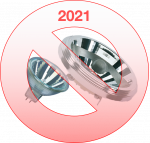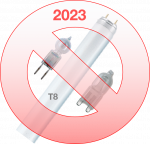Single Lighting Regulation - the "One for All" Directive for Light
In December 2019, the new ecodesign directive (EU) 2019/2020 has been published - so-called Single Lighting Regulation (SLR) or One Lighting Regulation (1LR). In order to achieve the energy-saving goals, the requirements for light sources and the necessary operating devices (control gear) go into a new round: from Sept.1st 2021, more lamp types will no longer be able to meet the minimum efficiency limit values and are therefore virtually banned from the European market: They may no longer bear the CE mark and therefore neither manufactured nor imported into EU.
![]() Above all, the process will be simplified: there is only one formula for all light sources. Full stop.
Above all, the process will be simplified: there is only one formula for all light sources. Full stop.
The differentiation is realized via light-source-specific correction factors (C, L, F, η and R), which can be established from tables.
Separate operational gear devices may not be entitled to carry the CE-marking any more, when their minimal energetic efficiency (at full load) cannot reach the required values quoted in table 3 or their energy consumption during stand-by-operation (idle/ stand-by) comes to more than 0.5 W.
As is known, the following also applies: lamps from previous production intervals with the CE mark - that is, stocks still in the ware houses - may be sold off and, of course, also used. However, it is worthwhile to think about energy-saving alternatives in most areas of application - not only to save energy effectively, but also from a lighting point of view.
Further, information requirements are of course also to be fulfilled: some technical data must already be provided on the light source, this and many others on the packaging and for operating devices, in some cases just on a freely accessible website.
What is a Light Sources according to the Directive?
All lamps and lights with fully integrated - i.e. non-interchangeable - components are light sources and therefore within the scope. 'Containing products' - generally speaking, luminaires for interchangeable light sources - are not affected.
The directive earmarks many exceptions or defines properties that take a light source out of its scope.
The most important exceptions:
- Under 60 lm or over 82000 lm
- Narrow beam (<10°)
- Infrared (except R7s in some special lengths)
- UV-emitters (> 2mW/klm)
- Special applications such as oven (300°C) or signaling
Timeline of Measures / Lamp Types Affected

Halogen low voltage lamps GU4, GU 5.3, G53
Halogen mains voltage lamps R7s > 2.700lm
Compact fluorescent lamps with integral ballast CFLi (Spin)
Fluorescent lamps NL-T12

Halogen low voltage lamps G4 and GY6.35
Halogen mains voltage lamps G9
Fluorescent lamps NL-T8 in standard lengths (600mm = 18W, 1200mm = 36W und 1500mm = 58W)
'Stay'  may in general (up to a few, less efficient single types):
may in general (up to a few, less efficient single types):
- Halogen mains voltage lamps R7s < 2.700lm
- Fluorescent lamps NL-T5 (apart from 80W)
- Compact fluorescent lamps without integral ballast CFL
- High pressure discharge lamps HRI, RCC and RNP
- LED retrofit lamps

